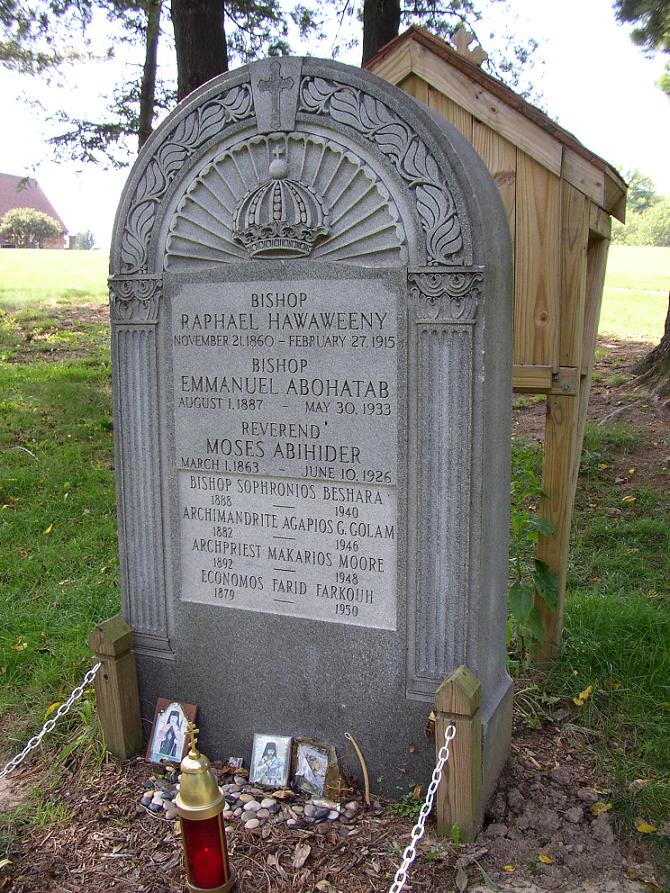Last week, I introduced Fr. Moses Abihider, a little-known Antiochian priest from the early 20th century. One thing we did know was that Fr. Moses was buried at the Antiochian Village along with St. Raphael, with whom he shared a tombstone. But… well, I was wrong about that one. See, before being moved to the Antiochian Village, St. Raphael had been buried at Mount Olivet Cemetery in Queens, NY. Fr. Andrew Damick pointed out to me that the tombstone may well have been moved from Mount Olivet along with Raphael’s body. If so, and unless the Antiochian Archdiocese also moved the other clergymen on the tombstone, it’s entirely possible that those clergymen are still in Queens.
I did some digging in my own files and found a copy of a June 23, 1988 letter from Metropolitan Philip to the Pennsylvania Department of Health, stating,
Please be advised that as the official hierarch of the Antiochian Orthodox Christian Archdiocese of North America, I hereby authorize the disinternment of the following clergymen from the Mount Olivet Cemetery in the town of Maspeth, Burough of Queens, State of New York, and the transfer of their remains to the newly-established church cemetery on the sacred grounds of the Antiochian Village located in Ligonier, Pennsylvania.
This is followed by, “Grave No. 50: Bishop Raphael Hawaweeny (died Feb. 27, 1915, reinterred at Mount Olivet ca. 1920)”.
A second letter, with the exact same date and wording, authorizes the transfer of the bodies of Bishops Emmanual Abo-Hatab and Sophronios Beshara from Grave 52.
In an earlier document, a 1965 letter from the superintendent of Mount Olivet Cemetery to “Miss G. Hatab” (probably a relative of Bishop Emmanuel), it is noted that Bishop Raphael was buried alone in Grave 50; Frs. Moses Abihider, Agapios Golam, and Makarios Moore were buried in Grave 51; and Abo-Hatab, Beshara, and Fr. Fred Farkouh were buried in Grave 52.
The upshot being that the three bishops — Raphael, Emmanuel, and Sophronios — were moved to the Antiochian Village along with the tombstone, while the four priests (including Fr. Moses Abihider) presumably remained at Mount Olivet. I don’t know whether the Antiochian Archdiocese provided new grave markers for those priests to replace the tombstone.
Another thing worth noting: as is apparent from the photo of the tombstone, the inscriptions for the latter four clergymen — Beshara, Golam, Moore, and Farkouh — were added to the tombstone later. (Those four also died later than the first three.) Thus, the original three names were Hawaweeny, Abo Hatab, and Abihider.
Which makes me even more curious to learn more about Fr. Moses Abihider. I mean, he of all people was considered important enough to be buired alongside (and share a tombstone with) Bishop Raphael and Bishop Emmanuel. What distinguished this parish priest? Why was he deemed “worthy” to be buried with two bishops?
We’ll have more on Fr. Moses in the near future.
This article was written by Matthew Namee.

Hi, I publish a free newsletter for my parish, Saint Peters in Pomona CA. I would like permission to print this article as well as the article on Saint Raphael Hawaweeny’s Funeral along with the pictures.
: )
Kimberlee Lukins
Thanks for asking. I don’t have any problem with you reprinting my work here, although I’m still gathering information, so you may want to wait until I’ve got a more definitive account of the story behind St. Raphael’s tombstone (and graves).
Regarding his funeral, that article is in the public domain, so you don’t need my permission to reprint it. But you certainly have my encouragement!